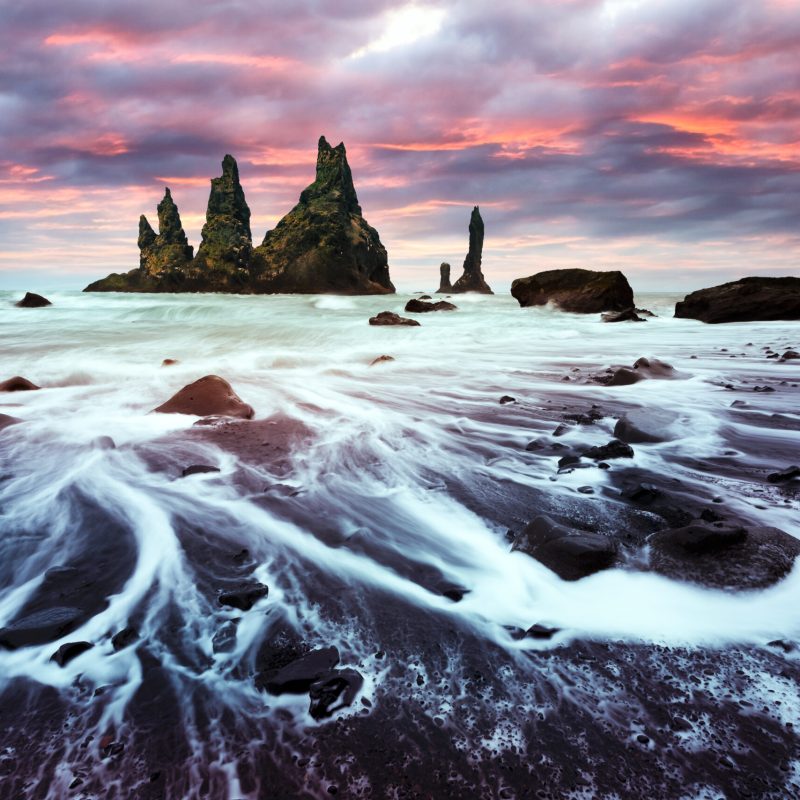
Marble tunnels carved by centuries of waves, rocks so white and bright they’re named after cotton, and blackened “skeletons” next to 1,000-foot-high dunes: These are just a few of the places on Earth that don’t actually look like they’re on this planet. And yet they are! Some of them are remarkably accessible, while others reveal their secrets only to the most adventurous travelers. Either way, they’re sure to inspire your next trip.
Videos by TravelAwaits

1. Lencois Maranhenses National Park, Barreirinhas, Brazil
A protected space since 1981, the Lencois Maranhenses National Park in northeast Brazil has to be seen to be believed. The park includes 43 miles of coastline, but that’s not the real attraction. The interior is filled with mile after mile of soft, rolling white sand dunes. During the rainy season, the valleys between the dunes fill with water. The result is a landscape of tiny turquoise lagoons, each begging to be explored.

2. Pamukkale Thermal Pools, Pamukkale, Turkey
The word pamukkale means “cotton castle” in Turkish. While this natural rock formation doesn’t exactly look soft and fluffy, it is every bit as dreamy as a cotton castle, especially at sunset. Made of limestone and shaped by calcium-rich hot springs, the formation resembles a terrace of overlapping infinity pools, the aqua waters lapping the edges of the snow-white rock. Bathing isn’t allowed in the terrace pools, but visitors can explore them on a path. If you can tear yourself away from the great views, the surrounding area is home to ancient ruins and fine museums.

3. Namib-Naukluft National Park, Namibia
At nearly 20,000 square miles, Namib-Naukluft National Park is the largest game park in all of Africa, but the real showstoppers are the unique topography and plant life. The park is home to the highest sand dunes in the world, almost 1,000 feet high. At their base is the Dead Vlei clay pan; its name translates to “dead marsh.” Long ago, the low-lying lands flooded, allowing camelthorn trees to grow. But when the drought came, the trees died, leaving their “skeletons,” now estimated to be 600 to 700 years old. The dead trees are essentially sunburned, giving them a blackened appearance. It’s an eerie but beautiful sight.

4. Snow Cave On The Mutnovsky Volcano, Kamchatka, Russia
A striking combination of strength and fragility, the snow-and-ice cave on the slope of Russia’s Mutnovsky Volcano is over a mile long. The tunnel was formed by the waters of a hot spring flowing between ice fields next to the volcano. Because the glaciers on the volcano have been melting, the roof of the cave is so thin it’s actually translucent. Sunlight streams down through the diaphanous ice, casting shadows and colors on the walls of the cave. For better or worse, the area gets very few visitors due to its extreme remoteness, but those who do make it are rewarded with unspoiled nature.

5. Fly Geyser, Black Rock Desert, Nevada
For its relatively small size, Nevada’s Fly Geyser packs a powerful punch. A geyser first emerged at the site in 1916 as a result of well-drilling explorations. The second attempt at a well in 1964 revealed a second geyser, with enough pressure to dry out the first. Together, they have spurted huge amounts of boiling water filled with minerals, resulting in magnificent rock formations and travertine pools. The water contains thermophilic algae, which produces multiple hues of green and red in the rocks. There’s nothing quite like the Fly Geyser in all of Nevada.

6. Reynisdrangar Rocks, Reynisfjara Beach, Iceland
According to Icelandic legend, the Reynisdrangar rocks were formed when two trolls dragged a three-masted ship toward land. When daylight broke, the trolls were turned to stone and the ship with them, forming the seas stacks that jut out into the waters off Reynisfjara Beach. Today, scientists believe that the structures were once connected to the Reynisfjall mountain range but were separated from it after many years of erosion. Regardless which origin story you prefer, the sharp, spiky rocks are well worth the trip to Iceland, as is the stark beauty of Reynisfjara beach.

7. Marble Caves On General Carrera Lake, Patagonia, Chile
Formed by melted glacial waters and surrounded by the Andes Mountains, General Carrera Lake is one of Patagonia’s most stunning sights. Fishermen love it for the abundant salmon and trout, but the fresh fish isn’t the lake’s star attraction. That would be the marble caves, a unique formation found nowhere else on Earth. In fact, the word “cave” doesn’t do the site justice. Thanks to 6,200 years of wave action, the marble has slowly transformed from solid rock to an intricate network of caverns, columns, and tunnels.

8. Lake Baikal, Russia
Siberia’s Lake Baikal has some serious bragging rights. It’s the largest freshwater lake in the world by volume. It’s also the world’s deepest lake, the world’s oldest lake, and — most importantly for visitors — the world’s clearest lake. During the annual winter freeze, the ice is transparent up to 3 feet deep. Visitors can see the naturally formed cracks, bubbles, and crevices in the ice. Walking across, you’ll feel like you’re walking on water — or even tiptoeing around the edge of an abyss!
Whether you dream of warm climates or cold, or find your solace in rocks, beaches, or water, these spectacular natural beauties will have you dreaming of your next travel destination.
